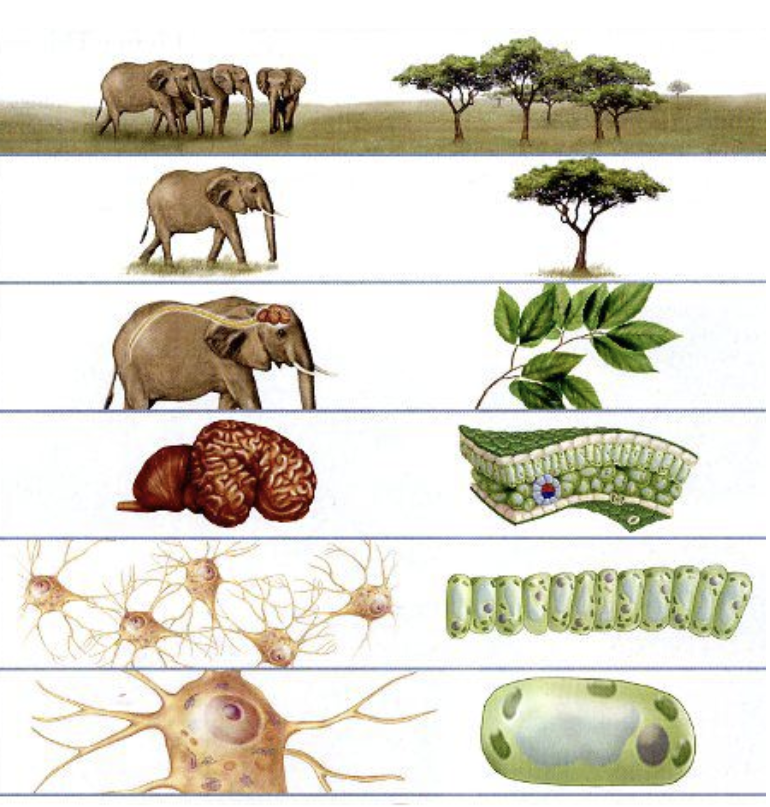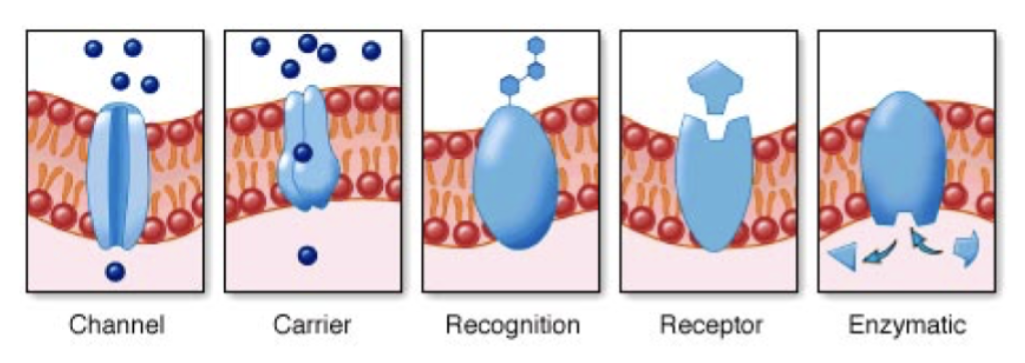Honors Biology Notes Grade 10 Highschool Unit 2:
U 2: Cells
Cell Organization of livings things:
 Population - Organisms of the same species in a particular area Population - Organisms of the same species in a particular area |
|---|
| Organism - An individual; contains a complex organ system |
| Organ System - Composed of several organs working together |
| Organ - Composed of tissues functioning |
| Tissue - A group of cells with a common structure and function |
| Cell - The structural and functional unit of all livings things |
Cell theory:
All organisms are composed of one or more cells.
The cell is the basic unit of the organization of living things.
All cells come from preexisting cells.
\n \n \n \n \n Cell Structure of living things: \n
4 structures are present in ALL cells
Cytoplasm - the cytosol holds all organelles in place, providing a place for all of the cellular reactions and items to be transported throughout the cell. Gelatin Like Structure.
Ribosomes - to read RNA instructions and to use those instructions to make proteins
Plasma (Cell) Membrane - Controls what moves in and out of the cell and is selectively permeable
DNA - contains the instructions needed for an organism to develop, survive, and reproduce
\n \n \n Prokaryotic and Eukaryotic cells
| Word | Definition | Diagram |
|---|---|---|
| \n ==Prokaryotic== | A cell that is unicellular, made up of fewer organelles, a single strand of DNA, and lacks a nucleus | |
| Additional structures that prokaryotes can have | Groups of organisms that are made of prokaryotic cells | How do they reproduce? |
| **Flagellum (Flagella):**Structure: Long, singular projections made of microtubules that move in a whip-like motion \n Function: propel the cell in a direction \n Cilia: Structure: are short, numerous, hair-like projections that move in a wavelike motion. Consists of a central pair of microtubules surrounded by nine additional pairs. \n Function: propel substances on a cell’s surface | Bacteria \n Archaea \n | Through a cell division process called binary fission. \n Binary Fission: asexual reproduction |
\n \n
| Word | Definition | Diagram |
|---|---|---|
| \n %%Eukaryotic%% | A cell that is multicellular, made of many strands of DNA, made up of many organelles, and has a nucleus. \n \n | |
| Additional structures that eukaryotes can have | What 4 groups of organisms are made up of eukaryotic cells? | How do they reproduce? |
| \n The nucleus contains the nuclear envelope (membrane), nucleolus, and Chromatin/DNA. \n It also contains membrane-bound structures. | \n Protists \n Animal Cells \n Plant Cells \n Fungi \n \n | Mitosis and Miosis \n (comes at unit 4) |
\n Prokaryotic and Eukaryotic Similarities and Differences
| [[Prokaryotic[[ | <<Similarities<< | }}Eukaryotic}} |
|---|---|---|
| [[Prokaryote: A unicellular organism that lacks a nucleus and membrane-bound organellesSmaller, simpler cells (1-10 microns)Single strand of DNA per cellExamples: Bacteria[[ | <<Both have genetic materialBoth have a cell membraneBoth have a cytosolBoth have ribosomesBoth contain nucleic acids, proteins, carbohydrates, and lipidsBoth use similar reactions for storing energy and metabolic activities (e.g.: Building proteins).<< | }}Eukaryote: A uni- or multi-cellular organism that is made of eukaryotic cellsContain a nucleus and membrane-bound organelles (organelles surrounded by a membrane)Larger, more complex cells (10-100 microns)Many strands of DNA per cellExamples: Protists, Fungi, Plants, Animals}} |
Eukaryotic Organelles
| Organelle/Structure | Function |
|---|---|
| Nucleus | Supports and protects the cell |
| Ribosome | Converts RNA into protein using the RNA instructions |
| Rough ER | Serves as an intracellular highway for the transport of materials and is covered in ribosomes |
| Smooth ER | Site of lipid metabolism in many cells, regulation of calcium in muscle cells, and breakdown of toxic waste in liver cells and is not covered in ribosomes |
| Golgi apparatus | Packages and modifies materials from the ER before they are sent to the cytoplasm/ cell membrane |
| Mitochondria | “powerhouse” of the cell; breaks down food (sugars) into energy (ATP) in a process called cellular respiration |
| Cytoplasm | The cytosol holds all organelles in place and provides a place for all of the cellular reactions to occur and items to be transported throughout the cell. |
| Lysosome | Enzymes in sacs digest worn-out cell parts or unwanted substances (invading viruses and bacteria) |
\n \n Cell Membrane: \n
| Function/Description | Diagram with labels |
|---|---|
| Controls what moves in and out of the cell; is selectively permeable (selectively permeable = selects what comes in and what leaves) \n \n \n \n \n \n \n |
\n
Describe the structure of the cell membrane in detail:
Composed of a bilayer of phospholipids, with the hydrophobic ends facing each other on the inside of the bilayer, and the hydrophilic ends on the outside (near the watery inside and outside of the cell).
\n
The Function of Cell Membrane:
Provide “packaging” to hold all the cell organelles together (the phospholipids do this)
Provide passageways for molecules to enter and leave the cell (The proteins do this!)
\n
Functions of Membrane Proteins
Transport
- Carrier Protein - carries a molecule across the membrane, like a revolving door would
- Channel Protein - provides a tunnel for a molecule to move through the membrane
Cell-To-Cell Recognition: ID tags on cells that tell what type of cell it is
Receptor/ Cell Signaling: Proteings that receive and send signals inside a cell and between other cells
Enzyme Activity: Proteins that are enzymes, but are attached to the cell membrane to preform their functions

| Phospholipid | Phospholipid bilayer (include the various proteins that are listed below) |
|---|---|
Describe the function of the various molecules found in the cell membrane:
Channel: provides a tunnel for a molecule to move through the membrane
Gated channel: opens a "gate," allowing a molecule to pass through the membrane.
Pump protein: These are transport proteins that require energy to do work (pump molecules across a membrane), The protein changes shape or moves in order to transport the molecules. This requires energy (ATP)!This is because the molecules will be moving from low concentrations to high concentrations!
Recognition proteins & carbohydrates: ID tags on cells that tell what type of cell it is
Receptor: Proteins that receive and send signals inside a cell and between other cells.
Cholesterol: Another type of lipid, these molecules fit between the tails of the phospholipids, type of steroid is cholesterol, and it provides support and rigidity.
\n \n \n
What would happen to a cell if the cell membrane were damaged? Why? If the functional properties of the cell will be lost and as a result, the cell will die.
What is a concentration gradient? Occurs when the concentration of particles is higher in one area than another.
\n
Passive Transport
Types of Passive Transport:
\n Diffusion: random movement of molecules down the concentration gradient (from areas of high concentration to low concentration) until equilibrium is reached
\n Facilitated diffusion: diffusion with the help of transport proteins (the protein makes a tunnel or doorway through which large or charged / polar molecules can pass through the non-polar portion of the membrane).
Osmosis: simple diffusion of water only
\n
Osmosis:
What are the 2 parts of a solution? ^^Solute^^ + ==Solvent== = %%Solution%%
\n ^^Solute: A substance that is dissolved in a solution. Solids^^
==Solvent: A substance that has the ability to dissolve a given solute to form a solution with it. Liquid==
\n
Define each of the solution types and describe what happens to cells when submerged in these solutions:
\n
Isotonic: Has equal concentration outside and inside of the cell.
Hypertonic: Has ^^more solute ^^==than solvents== in the solution. Example corn syrup \n
Hyptonic: Has ==more solvents ==^^than solute^^ in the solution. Example water
Active Transport \n
What is it?
- The cell uses energy to actively move molecules to where they are needed
- Movement from an area of low concentration to an area of high concentration
__ __
Types of active transport:
- Protein Pumps
- Endocytosis
- Exocytosis
| Protein Pumps | - These are transport proteins that require energy to do work (pump molecules across a membrane)- The protein changes shape or moves in order to transport the molecules. This requires energy (ATP)!- This is because the molecules will be moving from low concentrations to high concentrations! | |
|---|---|---|
| Endocytosis | - Takes bulky material into a cell - Uses energy to make the vacuoles- Cell membrane folds in around food particle“cell eating” forms food vacuole & digests food- This is how white blood cells eat bacteria! | |
| Exocytosis | - Forces material out of the cell in bulk- The membrane surrounding the material fuses with the cell membrane- Uses energy to make the vacuoles- Cell changes shape – requires energy- EX: Hormones /wastes released from the cell |
\n \n
How is active transport different from passive transport? Active transport uses energy, unlike Passive transport. Active transport wants to go from a low to a higher concentration, unlike Passive transport which does it the opposite way (high to low).
\n \n \n
Why do cells perform exocytosis: It Forces material out of the cell in bulk. The membrane surrounding the material fuses with the cell membrane, Uses energy to make the vacuoles, Cell changes shape – requires energy, EX: Hormones wastes released from the cell
\n
| Transport | ]]Passive]] | {{Active{{ |
|---|---|---|
| Energy required? | ]]No ]] | {{Yes {{ |
| The direction of movement? | ]]High to low concentration]] | {{Low to high{{ |
\n \n \n \n
| List and describe the functions of the special plant organelles in the table below: |
|---|
| Plant Organelles | Function |
|---|---|
| Cell Wall | Structure: Inflexible, porous structure composed of cellulose located outside the cell membrane. Outer boundary between a plant cell and its environment.Function: Supports and protects the cell |
| Chloroplasts | Structure: double membrane and contain their own DNA; enclosed system of flattened sacs called thylakoids; chlorophyll located hereFunction: Site of photosynthesis (conversion of light energy to chemical energy stored in sugar) |
| A central vacuole | Structure: membrane-bound sacsFunction: store substances for the cell, such as: water, food, salts, and proteins, waste to be excreted \n \n |
\n